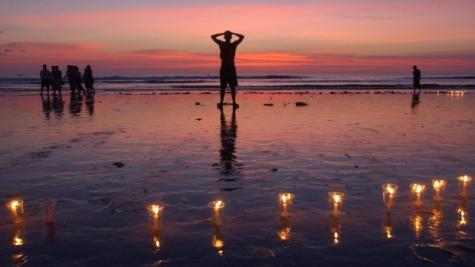Dr David Read had only been a surgeon for two years when he boarded a plane to Bali to treat the burned, broken and bloodied bodies dragged out of the bomb site.
10 years on: doctors remember:As we remember the 202 people who perished 10 years ago today in the Bali bombings, we hear from two of the doctors who helped.
Date: October 12 2012

Ten years on, and now aged 43, he recounted what happened with stunning clarity, from the delays in getting to the hospital in Bali - a traffic jam made it tough to reach - to the confusion in working out which victims to evacuate to Australia.
Arriving at Sanglah Hospital 18 hours after the bombing, there were still victims everywhere, and near silence as nurses and doctors worked on them, he said.
His instructions were just to evacuate Westerners, but with identification documents burned or missing, in practice it meant taking to Australia anyone who didn't look Asian.
"One guy from Singapore said he was Australian because he knew we would care for him," he remembered. The man was in due course taken to Australia and treated.
He will never forget performing surgery on people on the tarmac at Bali's main airport while volunteers held torches so he could see.
Once aboard the army Hercules plane, things remained desperate, with victims on stretches piled five people high.
"I had to do an escharotomy in flight. That is the cutting of the burn to release the pressure to stop the limb from dropping off, and we had run out of anaesthetic," he says.
One of the medics on board dropped to the ground and nearly fainted after what happened next.
"We did the procedure, but with the patient in sub-optimal anaesthetic conditions," he says.
The medic who was assisting then redeemed himself.
"The mark of a man is not how often they fall down, it is how quickly they get up, and he got up," Dr Read says.
With the plane flying at altitude, there were fears of the patients contracting hypothermia, and between treating the ill he was putting on blankets and changing bed pans.
A patient was apologising to him for having terrible Bali belly, which causes diarrhoea.
"He was saying 'I am so sorry, I s*** myself'."
"I said 'if that is your biggest problem at the moment, it is a good day for you young man'."
Many victims were taken to the Royal Darwin Hospital because it was the closest major hospital to Bali.
In a 36-hour period it dealt with more casualties than any single hospital after either 9/11 or the Oklahoma bombings in the United States.
Dr Len Notaras was working in Darwin soon after the bombing and is credited with deciding to call then prime minister John Howard and the foreign minister Alexander Downer to ask for the evacuations from Bali to occur.
"The initial intelligence we got was that there would only be walking wounded," he told a conference in Darwin on Saturday.
But the reports from the first doctors to go over were very different.
"They said the situation is dire and the people we are bringing back are in the worst possible health."
For a regularly busy emergency ward at the hospital, the strain on resources was tough.
In the end, the hospital treated 75 people with critical injuries, more than 55 people with significant burns and 15 people who walked in requesting help.
"These were patients who were critically injured, not just burns, but impalings and amputations," Dr Notaras said.
Only one of the people who reached the hospital on that night from Bali died.
|
||||||||














__small.png)










